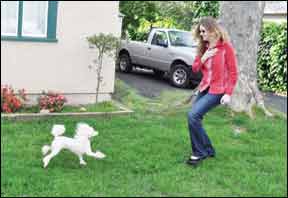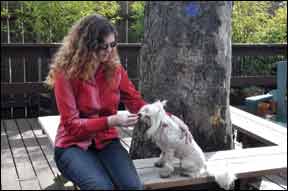I was recently contacted by a friend about a darling Border Collie puppy whose photo she found on Petfinder.com – and who was deaf. This friend is crazy about Border Collies, and also knows that I have a deaf Chinese Crested. Thus, she thought of me when she saw this puppy. The person who was fostering the pup was unable to keep her much longer, and did not want to send her to the local shelter as that would almost certainly result in the puppy’s euthanasia. Why? Because that shelter considers all deaf dogs as “unadoptable.”

This concept is common – and dead wrong. Many people assume that deafness somehow makes a dog untrainable, or that training a deaf dog will require an enormous amount of extra training to prevent tragedy. In reality, training any dog requires time, regardless of whether she can hear or not. Training a deaf dog requires some common sense, but not a ton of extra training. It is unfortunate that deafness often results in a death sentence for perfectly healthy dogs.
Congenital Deafness
Congenital deafness is deafness that a dog is born with. Dr. George M. Strain, Professor of Neuroscience at Louisiana State University School of Veterinary Medicine, has found that congenital deafness in companion animals is most commonly inherited from a deaf parent, but may also skip generations.
Dr. Strain lists 92 dog breeds with reported congenital deafness, though he notes that individuals of any breed can have congenital deafness from a variety of causes. Breeds with white pigmentation are most commonly affected, with Dalmatians, Bull Terriers, Australian Shepherds, and Australian Cattle Dogs frequently reported to be partially or completely deaf. Out of more than 5,600 Dalmatians tested for deafness, 441 (7.8%) were reported to be bilaterally deaf, and out of 442 Australian Cattle Dogs tested, 11 (2.5%) were bilaterally deaf. Dr. Strain is currently gathering data on the prevalence of congenital deafness in other breeds.
Are deaf dogs different? It’s often suggested that deaf dogs are prone to biting when startled. The truth is that any dog can nip or bite when startled – it’s just easier to startle a deaf dog than a dog who hears your approach. It’s important to desensitize your dog, hearing or deaf, to touch (for more on this, see “Stay in Touch,” WDJ Jan 2011).

It’s also a good idea to choose a specific place (shoulder, hip, etc.) to lightly touch your deaf dog as a cue for “pay attention to me” – the equivalent of calling a hearing dog’s name. It’s best to start while your dog is awake and looking at you. Lightly touch this area and feed your dog a treat. Repeat many times. Work up to the point where you can give your dog a light touch while she is looking away and she turns her head toward you with a happy look.
I use a light touch to get my dog’s attention when other methods aren’t convenient. Other methods to get your deaf dog’s attention might include a good stomp on the floor, a flashlight, or a remote-controlled vibration collar. Before relying on these methods to get your dog’s attention, first teach your dog the meaning of them by pairing them with good things – treats, toys, and/or attention.
Another myth about deaf dogs is that you cannot call your dog back if she runs away from you into a dangerous situation. It goes without saying that you should not let a deaf dog run free in any place that you would not let a hearing dog run free. However, there may be an occasion when your dog inadvertently gets away from you. Teaching your deaf dog to “check in” with you frequently, and thus being able to see your non-verbal cue, will aid in preventing disaster.
You can also use a remote-controlled vibration collar to get your dog’s attention over some distance. These devices vary in their maximum range (from as little as 100 feet to more than a mile), but many have an additional shock element, which I do not recommend. Just as a hearing dog must be trained to respond to a recall cue, a deaf dog also must be trained to respond appropriately to a collar vibration. But remember, any dog can have selective “hearing” when recalled unless the behavior is practiced and proofed.

Not Any More Difficult Than Training Any Dog
Deaf dogs are not any harder to train than hearing dogs. It just takes a little practical consideration to train without sound. As a clicker trainer, I use a conditioned reinforcer to mark correct behavior. Since a completely deaf dog cannot hear a clicker, I have found that a keychain flashlight works well. I choose a small flashlight that turns on when the button is pressed and turns off when the button is released – just like a clicker.
As a backup marker, much like using the word “yes” when I do not have a clicker on me, I use a “thumbs up” gesture. It took practice for me to remember to put the thumbs up away quickly, instead of holding it up for an extended period of time and marking more than just the behavior I want. Another practical consideration is that when you mark a behavior with a thumbs up, the dog must be looking at your hand to perceive it. Thus, you must be in your dog’s line of sight while she does the behavior. I prefer the keychain flashlight, because the light can be perceived in the dog’s peripheral vision, thus allowing your dog to focus on what she is doing instead of watching for the thumbs up.
When I explain clicker training in my orientation seminar for basic obedience courses, I use my deaf dog as my demo dog. In my experience, deaf dogs take to “clicker training” just as well as hearing dogs. An added benefit to working with a deaf dog is that they are not distracted by background noises during training. Using my deaf dog in demonstrations highlights the fact that there is nothing magical about a clicker – it is just a convenient tool.
Some people ask if a keychain flashlight would be a good event marker for their hearing dogs. In my opinion, no; light is not quite as versatile as a clicker. It’s difficult to see in bright light, whereas the clicker is a distinct sound that can be perceived in most situations, even in a noisy room, and from a distance.
Some trainers use a “no reward marker” (NRM) during a training session when a dog is not on the right track. It would be easy to use a specific hand signal (maybe a thumbs down?) to act as a NRM.

What to Use as Cues?
Without hearing, deaf dogs must rely on their other senses. They are quite attuned to body language, human and dog alike. It makes sense that the majority of cues that they are taught would be visual, including hand signals, body posture, foot position, and eye contact.
Some owners of deaf dogs use American Sign Language (ASL) hand signals as cues. This lends consistency in hand signals for deaf dogs, and is a resource for possible hand signals for us unimaginative folk. Unfortunately, few people are fluent in ASL. Also, it’s inconvenient to use two hands for a cue, as one hand is needed to mark the correct behavior, deliver a treat, and possibly hold onto a leash during training.
I sometimes use letters of the ASL alphabet for behaviors ( “n” for nose touch, “l” for lick) as they only require one hand and are distinct, but I made up most of the hand signals I use with my deaf dog. Her signal for “heel” is a double tap on my left leg. “Leave it” is a flat hand shaken side to side in front of her face. “Spin left” is a flick of the right hand to the right (toward her left side).
Just as you wouldn’t shout when you teach a new verbal cue to a hearing dog, hand signals need not be exaggerated, just perceivable by the dog.
To Talk or Not to Talk?
I do feel that clicker training a deaf dog has made me a better trainer for hearing dogs. It highlights the fact that verbal coaching while training is unnecessary, and can actually get in the way when trying to give consistent cues.
On the other hand, when talking to our dogs our body language naturally and unconsciously changes. Talking to your dog can actually aid in keeping her attention, and in conveying praise and excitement. By talking to your dog you actively engage her. Your entire body conveys that your attention is on her, and this is something which even a deaf dog will be able to pick up.
The lesson is to talk less when training new behaviors, but to talk when you want to keep your dog’s attention and as praise for a job well done.
For example, you want to keep your dog’s attention while heeling. Try silently heeling with your dog, then try happily talking to your dog while heeling. Your body language changes – when you talk to the dog, you will be more animated – and your dog will notice. If talking to your deaf dog produces better results, talk away!
What Does a Deaf Dog Need to Know?
Here are five things that I believe are the most important for deaf dogs to learn:
1. Socialization – Your dog should be comfortable with novelty; new places, people, animals, etc.
2. Touch – Your dog should be comfortable being handled all over.
3. Eye contact/attention – Remember, your deaf dog must be looking at you to perceive your cues.
4. Checking in – Your dog should regularly look to you in case you might give a cue.
5. Emergency recall – In an emergency, you must be able to cue your dog to come back quickly.
Note that these things are important for all dogs – not just deaf dogs. I tend to focus more on touch desensitization and checking in with deaf dogs than with hearing dogs, but otherwise work on the same concepts in the same amounts. If you do not have dog training experience, I would recommend finding a positive reinforcement trainer who is open to working with a deaf dog.
Deaf dogs are not more difficult to train than hearing dogs if you use common sense while training. They are very responsive to hand signals and body language and don’t often startle at unexpected noises. The things that are important for hearing dogs to learn are just as important to deaf dogs. If you find yourself with an opportunity to work with a deaf dog, consider it a learning experience!
Author and trainer Cindy Rich, KPA CTP, of The Canine Connection in Chico, California, has modelled for WDJ photos for a while, but this is her first written contribution to the magazine.






